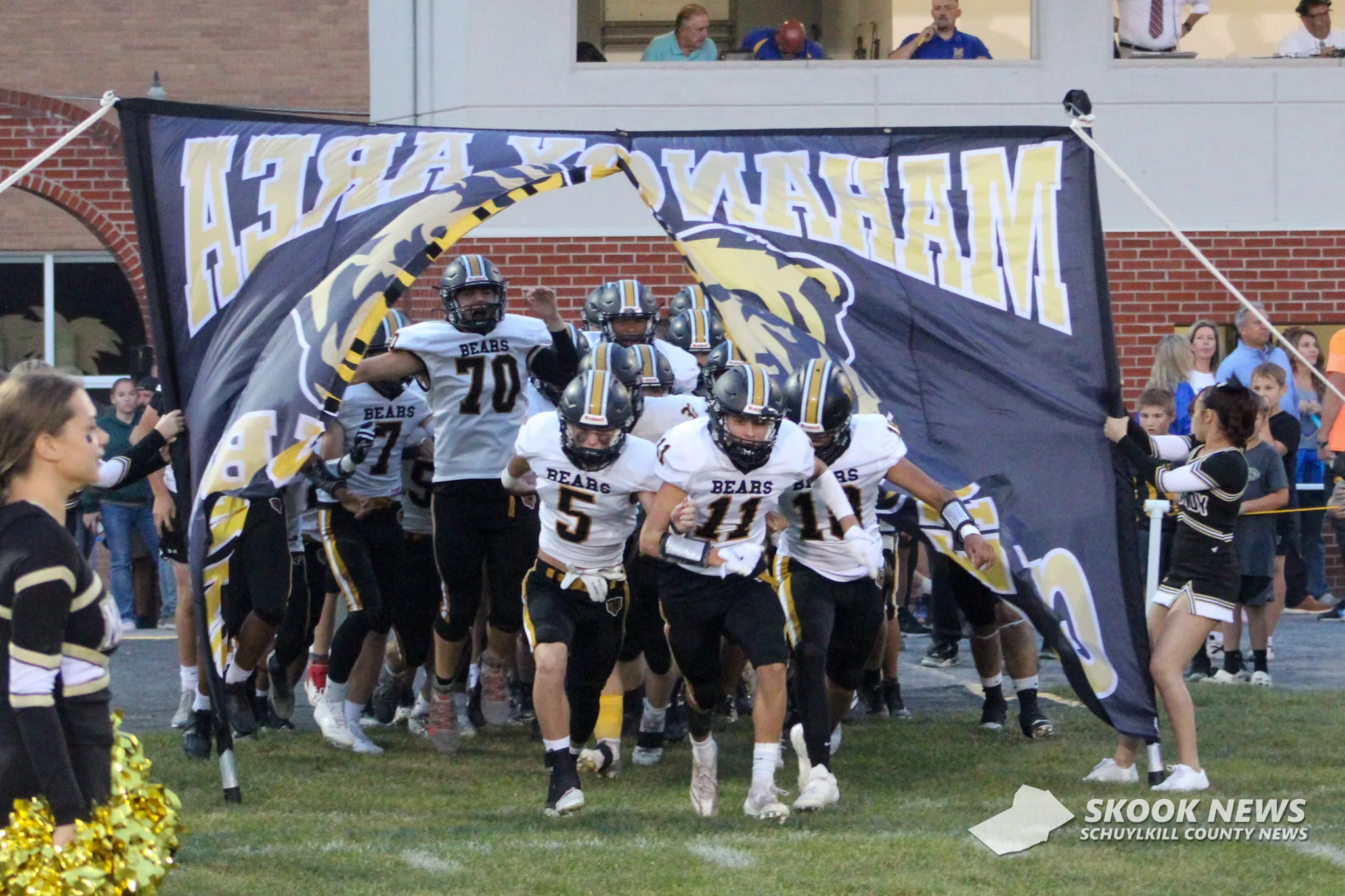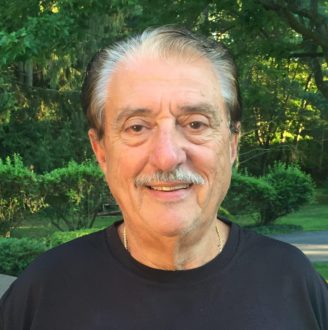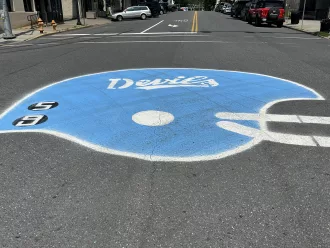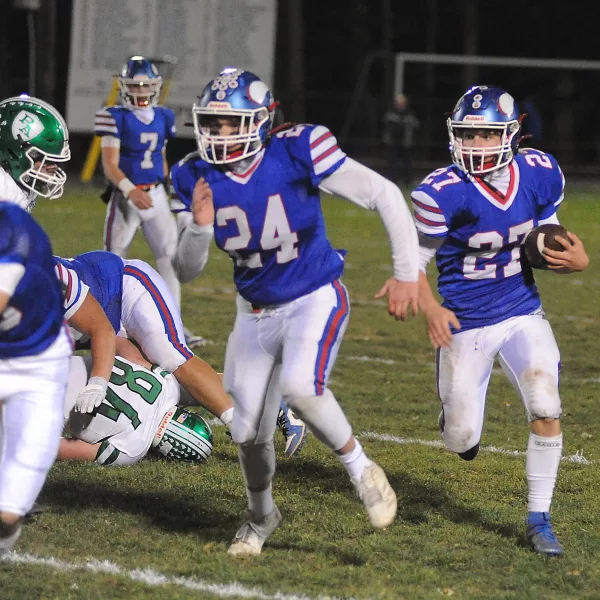Mahanoy Area-Shenandoah Valley rivalry stands test of time

Mahanoy Area will host Shenandoah Valley on Friday night for the annual Damato-Szematowicz rivalry game. (Photo by Justin Reed/Skook News)
It was once considered a “battle royale.” Some even dubbed it the Army-Navy Game of the Coal Region.
It was for bragging rights, a year-long honor when the pundits debated who was the king of football between the these two Coal Region towns.

To think, this football ongoing series, started before Henry Ford invented the automobile, is hard to fathom as it began in 1899. That in itself tells you the history of this great rivalry, ancient rivalry. It was once dominated by the Blue Devils: Now it is a mere shell of itself. Mahanoy Area is king of this series, having won 11 straight meetings. The Golden Bears don’t have to bring out the coveted Damato-Szematowicz “Gold Star” Trophy, just house it in the trophy case at Mahanoy Area High School. The trophy was named after two World War II deceased heroes who died in combat: Anthony P. Damato, Shenandoah, and James Szematowicz, Mahanoy City.
Back in the 1930s, legendary Blue Devils icon coach, the late Bobby Nork, once said he could start his second team and beat Mahanoy City High School. The two towns had their own high schools, before jointures became a craze. Nork did start his second team and watched as the Maroons stormed in front 13-0. Then Nork inserted his stable of talent to come from behind to win the game, barely, 14-13. There was bad blood between the two schools, in a good way. The Blue Devils football program was so dominant they seldom lost; from 1929 to 1943, they lost a total of 27 games, while winning 127 times.
To be sure, this was the pride of both communities. Actually, it was a big event and moved to Thanksgiving Day being held every year at 10 a.m. Before the two towns played the game on Turkey Day, the Blue Devils used that date to play Tamaqua, before the rivalry game was rescheduled. Fans came in droves Thanksgiving morning. Afterward, the winning team would enjoy their feast better than the losers. The gravy tastier, the filling moist and hot; the drumsticks so enticing to dive into; the losers’ meal didn’t feel so sumptuous, sort of hard to swallow.
“The Gold Star Trophy Game,” as it is referred in modern times, began in 1945, before being discontinued after the 1958 game, then reborn thanks in part to a pair of former players. The late John Murtin, who was then superintendent at Mahanoy Area, and the late Charles “Chuck” Nowak, who served as the Shenandoah Valley business manager, get the credit for the rebirth of the series.
Sometimes there was bad blood and it came to a head in 1958. As legend has it, both teams were to play on the 10th playing date at the old East End Stadium in Mahanoy City. However, forecasters called for rain on that evening, but it only did sparingly, a drizzle that never came pouring down. Rumors swirled Friday evening that a fire company in Mahanoy City was dispatched to water down the field.
Why? The Maroons were a bigger team, the Blue Devils small, but very athletic and very speedy, with their two terrific running backs, Bobby Buckanavage and Bobby Piekarsky. The Maroons’ featured line was led by Jim Rhoades, a big tackle who was being touted as an All-State lineman, and later would become one of the area’s finest state senators. Other leaders were quarterback Eddie Dougherty and Johnny Pilconis, son of the coach, Joe Pilconis.
Just the week before, the Blue Devils had dominated Mount Carmel in the famed Silver Bowl, 25-0, before more than 12,000 fans. The Mahanoy City High School team lost to that same Mount Carmel team by more than four touchdowns. Thus, Shenandoah was installed as the favorite. Again, according to legend, the wet field favored Mahanoy City High School.

Former players on both sides argue to this day how a goal-line stand by Mahanoy City turned the Blue Devils’ bid away prior to halftime, from inside the 1-yard line. On whose version does one agree with? There was a timeout called with 10 seconds to play in the half, mainly because Bernie Gazen, the Shenandoah coach and Mahanoy City native, wanted to stop the clock for a first-down measurement. Gazen protested vehemently that his team had crossed the goal line on the previous play, for his players upsettingly argued as well. The Maroons disagreed, just as strongly as the Blue Devils, for some to this day. The line judge on that play, former Cass Township coach Pat Droskinas, made the call. He never was welcomed with open arms in Shenandoah thereafter.
Both teams were tied at 0-0 at the halftime. But with less than three minutes to play, the Blue Devils, a primarily running team using the single-wing, dropped back to pass. The ball was intercepted by Johnny Pilconis and returned 80 yards for what would be the game-winning touchdown, 7-0.
As was the custom back then, both teams would engage in a dinner following the game. There was bitterness in the Shenandoah quarter feeling the remorse of the loss. It also ended the series before it was brought back 1995, thanks to Murtin and Nowak.
Twas not too long ago when it was a huge encounter. The stands were filled, even if one team had zero wins; there was always the anticipation that the underdog could pull off a stunner. It happened every so often, but it hasn’t come close for the underdogs in more than a decade.
One of the most memorable encounters happened twice in the same season. The Mahanoy Area jointure came after the 1958 season and enjoyed early success. When the late Bill Fazio took over the program, he turned a dormant club into a huge success. His teams won Eastern Conference championships, which was a big deal, since the state tournament didn’t come into existence until 1988.
The Golden Bears and the Blue Devils met twice in 1986; both times the Bears prevailed. The first meeting was the annual Backyard Brawl at Mahanoy Area. The Bears, with a terrific defense and ground chuck offense, stormed passed the Blue Devils 13-3. Both teams advanced to the championship game of the Eastern Conference Class C playoffs. Before a standing-room-only crowd, on the Saturday after Thanksgiving, Mahanoy Area scored a late touchdown thanks to a 55-yard run to the house by Dan Kern for an 8-0 victory.
This game meant so much to one former player, the deceased James J. Rhoades. After Friday evening’s game at Alumni Stadium, on Bill Fazio Field, a trophy will be presented in honor of Rhoades by his widowed wife, Mary Edith Holland Rhoades, along with her son, James. The late senator’s other son, Mike Rhoades, the head basketball coach at Penn State, cannot attend because of his coaching position. The annual dinner has also been revived and was set for Thursday evening in the Mahanoy Area High School cafeteria, with the host school providing the dinner for the seniors.
A History of the Damato-Szematowicz “Gold Star” Trophy
The following article, written by the late William “Babe” Conroy, appeared in the Hazleton Standard Speaker on Nov. 2, 1995. It is reprinted here in its entirety with the permission of the author. The football teams of Mahanoy Area and Shenandoah Valley will be playing for more than pride when they meet for the 75th straight year. They will be playing for a trophy named for two true heroes that has been laying in storage for 37 years.
The Damato-Szematowicz Trophy was awarded annually from 1946 to 1958 to the winner of what was then the Mahanoy City vs. Shenandoah game. However, the tradition ended in 1959 after the Mahanoy Area School District was formed.
John Murtin, former Mahanoy Area superintendent, is a memorabilia collector and recalled how he was reminded of the trophy. “I was at a meeting in the spring and Chuck Nowak was there,” Murtin said. “He brought up how Mahanoy and Shenandoah used to play for the trophy. When I told him I had it, he said, ‘Well, give us a chance to win it back.’ ” Nowak, the Shenandoah Valley business manager, died unexpectedly that June, but he and Murtin had already decided that following season would bring about the renewal of awarding the trophy to the winner of the annual rivalry.
The names themselves make the trophy a reverent piece of history. Cpl. Anthony P. Damato was a member of the 2nd Battalion, 22nd Marine Division, 5th Amphibious Corps. He was killed on the night of Feb. 19-20, 1944, in the Marshall Islands when he threw himself on an enemy grenade in a foxhole to save other Marines.
For what President Franklin D. Roosevelt termed “conspicuous gallantry and intrepidity” in his presidential citation, Damato was awarded the Congressional Medal of Honor posthumously.
The American Legion Medal of Honor Post No. 702 in Shenandoah is named in his honor. His sister, Mary, still resides in Shenandoah and another sister, Mrs. Joe Neddo, lives in Mahanoy City. A brother, Cmdr. Morris Damato, lives in Stafford, Virginia. Army Air Corps Pvt. Jerome Szematowicz was a chief mechanic with the Material Squadron. He was killed at Hickam Field in Pearl Harbor, Hawaii, when the Japanese staged their sneak attack on Dec. 7, 1941. He was awarded the Purple Heart for his service to his country. A sister, Mary Macknis, resides in Mahanoy City.
Both of these men for whom the trophy is named also had brothers killed during WWII. Damato’s brother Neil, a captain in the Army Air Force, was listed as missing in action on Nov. 5. 1943. Szematowicz brother, Stanley, was killed in Italy and both brothers were buried at the same time after the war when their bodies were returned to the United States and interred in Saint Casimir’s Cemetery, Mahanoy City.
Friday night’s game between the Bears and Devils at Alumni Stadium honors the memory of these war heroes.
A History of the Mahanoy-Shenandoah Rivalry
The first recorded gridiron contest between Shenandoah and Mahanoy City occurred in 1899 when Shenandoah bowed to Mahanoy City by a score of 5-0. Though the rivalry continued between the two schools, the game did not take place each year. Records indicate that between the inaugural game in 1899 and when the consecutive game streak began in 1921 (or a period of 22 years) Mahanoy City and Shenandoah met on the gridiron 10 times. Except for the 1917 game when Shenandoah prevailed, Mahanoy City won seven of the remaining games. A tie occurred in 1918 and there is no recorded score for the 1916 game.
The 1921 gridiron battle began a 103-game consecutive streak that continues with this, the 2024 contest, the 116th meeting between Mahanoy and Shenandoah. Since the first game in 1899, the cumulative record stands with Shenandoah prevailing 60 times, Mahanoy 49 times, and 6 recorded ties.
Related Posts

PIAA Football: Williams Valley game moved to Saturday
- November 22, 2024·
Touchdown Tips Week 14
- November 22, 2024·










